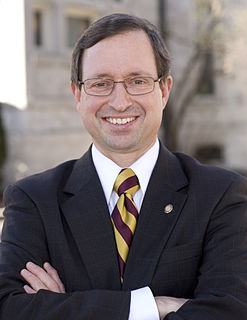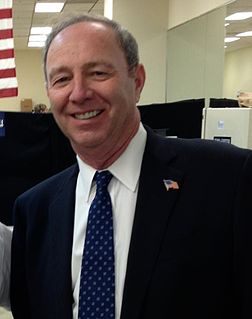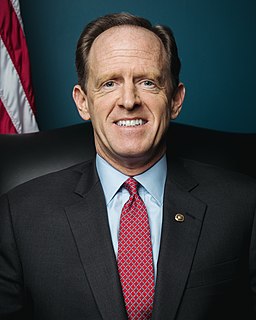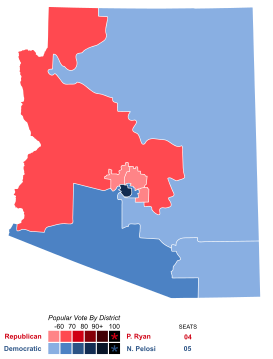
The 2006 United States Senate election in Pennsylvania was held November 7, 2006. Incumbent Republican Rick Santorum ran for re-election to a third term, but was defeated by Bob Casey, Jr., the son of Former Pennsylvania governor Bob Casey Sr. Casey was elected to serve between January 3, 2007 and January 3, 2013. Santorum trailed Casey in every public poll taken during the campaign. Casey's margin of victory was the largest ever for a Democratic Senate nominee in Pennsylvania, and the largest margin of victory for a Senate challenger in the 2006 elections. When Casey took office two months later, he became the first Democrat sworn in for a full term in the Senate from Pennsylvania since Joseph S. Clark Jr. won a second term in 1962.
The Republican Party of Pennsylvania, commonly known as the PA GOP, is based in Harrisburg in the United States state of Pennsylvania. It is affiliated with the Republican Party of the United States.

The 2010 Pennsylvania gubernatorial election was held on November 2, 2010, to elect the Governor and Lieutenant Governor of Pennsylvania, concurrently with elections to the United States Senate in Pennsylvania and other states and elections to the United States House of Representatives and various state and local elections.

Samuel E. "Sam" Rohrer is an American businessman and politician. A member of the Republican Party, he served as a member of the Pennsylvania House of Representatives from the 128th District.

The 2012 United States Senate election in Nebraska took place on November 6, 2012, concurrently with the 2012 U.S. presidential election as well as other elections to the United States Senate and House of Representatives and various state and local elections.
Timothy Richard "Tim" Burns is a Pennsylvania businessman. He ran as a Republican in the 2010 special election to represent Western Pennsylvania's 12th congressional district in the U.S. House of Representatives. Burns won the party nomination but lost the November general election to Democratic incumbent Mark Critz. From mid-October 2011 until ending his campaign in early February 2012, Burns was a candidate for the Republican nomination for United States Senate to challenge incumbent Senator Bob Casey, Jr. in the 2012 election.

The 2012 United States Senate election in Utah took place on November 6, 2012, concurrently with the 2012 U.S. presidential election as well as other elections to the United States Senate and House of Representatives and as various state and local elections. Incumbent Republican U.S. Senator Orrin Hatch won re-election to a seventh term against former state Senator and IBM executive, Scott Howell the Democratic candidate. This would be the last time Orrin Hatch is elected to the Senate, following his retirement.

Robert Patrick Casey Jr. is an American attorney and politician serving as the senior United States Senator from Pennsylvania, a seat to which he was first elected in 2006. He previously served as Pennsylvania Auditor General from 1997 to 2005 and as Pennsylvania Treasurer from 2005 to 2007.
The 2012 U.S. House of Representatives elections in Connecticut were held on Tuesday, November 6, 2012, to elect the five congressional representatives from the state, one from each of the state's five congressional districts. The elections coincided with the elections of other federal and state offices, including a quadrennial presidential election, a U.S. Senate election, and state legislature races.

The 2012 United States House of Representatives elections in Pennsylvania were held on Tuesday, November 6, 2012, to elect the 18 U.S. Representatives from the state of Pennsylvania, a loss of one seat following the 2010 United States Census. The elections coincided with the elections of other federal and state offices, including a quadrennial presidential election and an election to the U.S. Senate. Primary elections were held Tuesday, April 24.

The 2014 Pennsylvania gubernatorial election was held on November 4, 2014, to elect the governor and lieutenant governor of Pennsylvania, concurrently with elections to the United States Senate in other states and elections to the United States House of Representatives and various state and local elections.

Thomas Joel "Tom" Smith was an American politician and businessman from Pennsylvania. A Democrat for four decades before seeking elective office, Smith switched his registration in 2011 and ran for the United States Senate in the 2012 election as a Republican, losing to the incumbent Democratic Senator Bob Casey Jr.
The 2014 United States House of Representatives elections in Georgia were held on Tuesday, November 4, 2014, to elect the 14 U.S. Representatives from the state of Georgia, one from each of the state's 14 congressional districts. The elections coincided with the elections of other federal and state offices, including Governor of Georgia and U.S. Senator.

The 2014 United States House of Representatives elections in Pennsylvania were held on Tuesday, November 4, 2014, to elect the 18 U.S. Representatives from the Commonwealth of Pennsylvania, one from each of the state's 18 congressional districts. The elections coincided with other elections to the United States Senate and House of Representatives and various state and local elections, including the Governor of Pennsylvania and Lieutenant Governor of Pennsylvania.

The 2016 United States Senate election in Pennsylvania took place on November 8, 2016, to elect a member of the United States Senate to represent the State of Pennsylvania, concurrently with the 2016 U.S. presidential election, as well as other elections to the United States Senate in numerous other states and elections to the United States House of Representatives and various state and local elections. The primaries were held on April 26. Incumbent Republican U.S. Senator Pat Toomey was reelected to a second term in office, defeating Democratic nominee Katie McGinty and Libertarian Party nominee Edward Clifford.

The 2016 United States House of Representatives elections in Pennsylvania were held on November 8, 2016, to elect the 18 U.S. Representatives from the Commonwealth of Pennsylvania, one from each of the state's 18 congressional districts. The elections coincided with the 2016 U.S. presidential election, as well as other elections to the House of Representatives, elections to the United States Senate and various state and local elections. The primaries were held on April 26.

The 2018 United States Senate election in Pennsylvania took place on November 6, 2018, to elect a member of the United States Senate to represent the State of Pennsylvania, concurrently with other elections to the United States Senate, elections to the United States House of Representatives, and various state and local elections. The primary elections were held on May 15.

The 2018 Pennsylvania gubernatorial election took place on November 6, 2018, to elect the Governor and Lieutenant Governor of Pennsylvania, concurrently with the election of Pennsylvania's Class I U.S. Senate seat, as well as elections to the United States House of Representatives and various local elections. Incumbent Democratic Governor Tom Wolf won re-election to a second term by a double-digit margin, defeating Republican challenger Scott Wagner and two third-party candidates from the Green Party and Libertarian Party, respectively. The primary elections were held on May 15.

The 2018 United States House of Representatives elections in Arizona were held on November 6, 2018, to elect the nine U.S. Representatives from the state of Arizona, one from each of the state's nine congressional districts. The elections coincided with the 2018 Arizona gubernatorial election, as well as other elections to the House of Representatives, elections to the United States Senate and various state and local elections. The 2018 general elections saw the Democratic party gain the 2nd Congressional district, thus flipping the state from a 5–4 Republican advantage to a 5–4 Democratic advantage, the first time since the 2012 election in which Democrats held more House seats in Arizona than the Republicans.






















